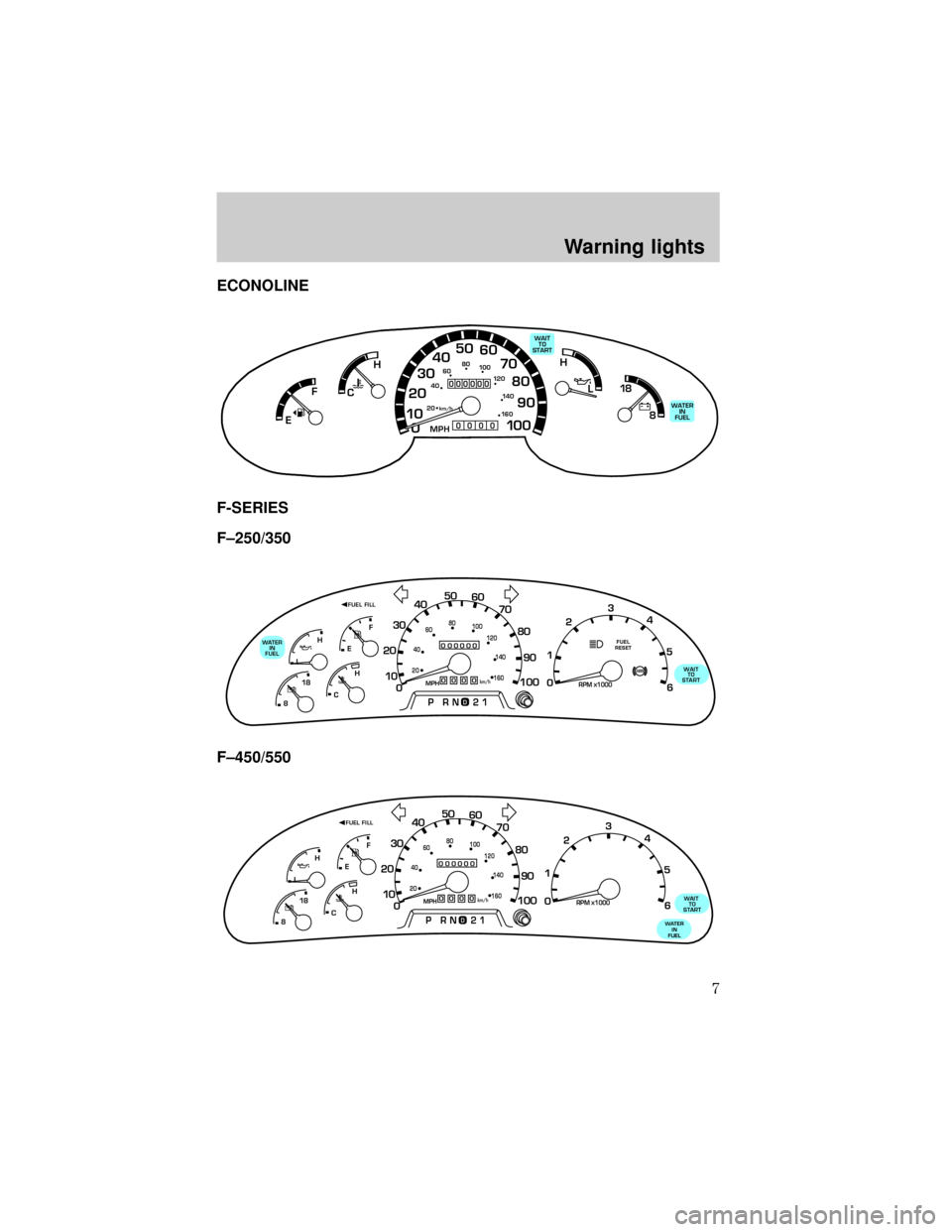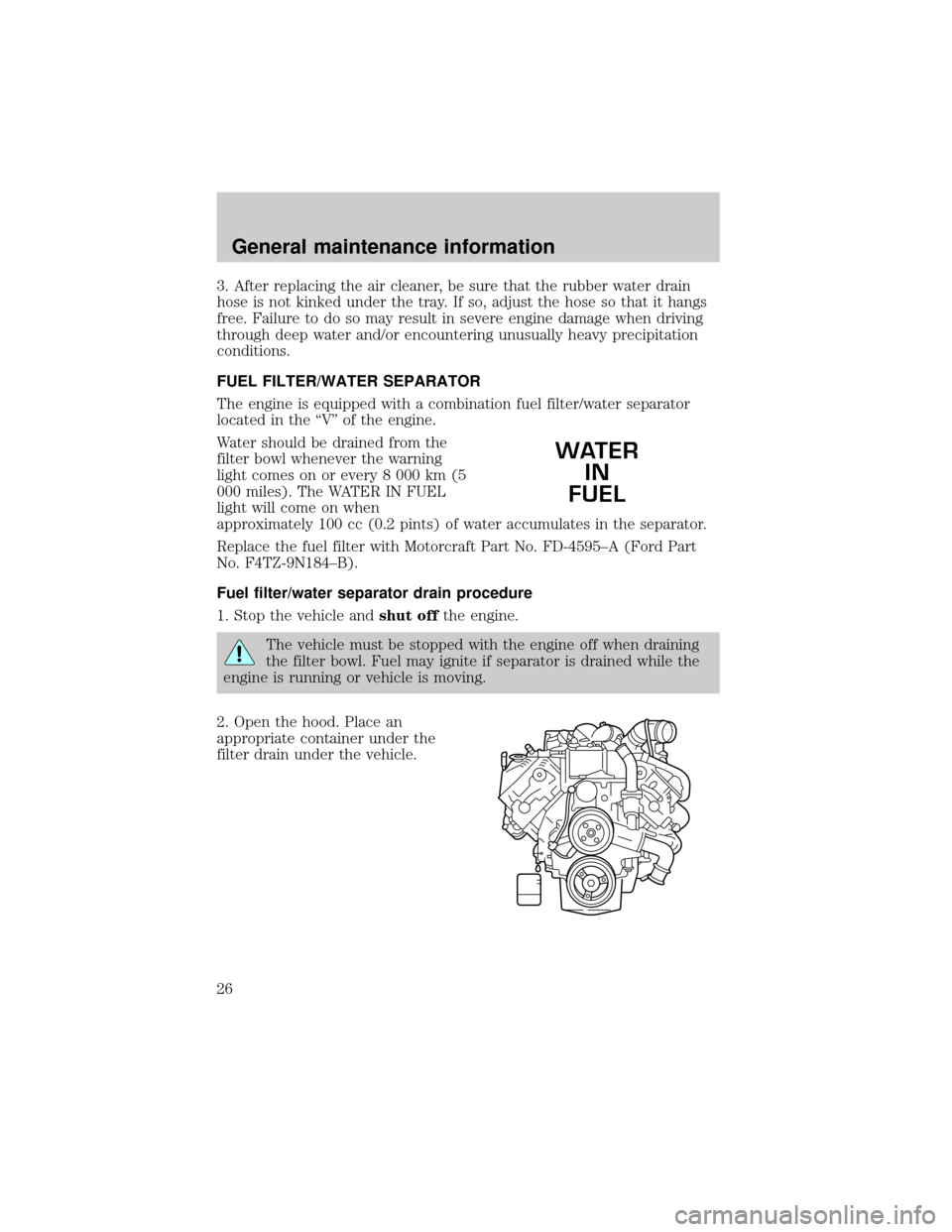1999 FORD E SERIES light
[x] Cancel search: lightPage 1 of 39

Introduction 2
Diesel information 4
Warning lights 7
Starting 9
Driving tips 14
General maintenance information 19
Scheduled maintenance 32
Minor troubleshooting guide 33
Capacities and specifications 36
Service points 38
All rights reserved. Reproduction by any means, electronic or mechanical
including photocopying, recording or by any information storage and retrieval
system or translation in whole or part is not permitted without written
authorization from Ford Motor Company.
Copyright
r1998 Ford Motor Company
Table of contents
1
Page 4 of 39

DIESEL ENGINE INFORMATION
The diesel engine fuel system consists of:
²a frame-mounted electric fuel supply pump
²an engine mounted fuel filter/water separator
²a fuel restriction sensor
²a unit injector for each cylinder
The combination fuel filter/water separator removes both water and
impurities from the fuel. The filter should be changed at the
recommended service interval. Refer to the ªService Guideº for more
information. The filter bowl should be drained at regular intervals or
when the ªWATER IN FUELº light illuminates in the instrument cluster.
The fuel injectors are located in the center of the combustion chambers
in the cylinder head between the rocker arm assemblies. The glow plug
system and fuel injection system are controlled through the powertrain
control module (PCM).
Fuel is drawn from the fuel tank by a frame-mounted electric fuel pump.
The fuel pump provides pressurized fuel to the engine and is
electronically controlled by the fuel pump PCM relay. The fuel pump
contains a pressure relief valve for overpressure protection in the event
of restricted flow.
Lubrication system
It is important to change the engine oil at the recommended service
intervals, because oil viscosity is important in maintaining the oil
pressure required to actuate the fuel injectors. Extended oil change
intervals can negatively affect engine performance and fuel economy.
The turbocharger, which is supplied pressurized oil, is also used to
actuate an exhaust backpressure warm-up system (if equipped).
Pressurized oil returning to the turbocharger is routed to the exhaust
backpressure actuator. During exhaust backpressure operation, the
engine's sound will be altered and you may notice a change in engine
performance while it's engaged. This function occurs only during cold
weather warm-up cycle.
Diesel information
4
Page 7 of 39

ECONOLINE
F-SERIES
F±250/350
F±450/550
0 1020304050
60
70
80
90
10 0
20 km/h
406080
10 0
12 0
14 0
H
L
16 0
MPH
000000
0000
18
8
WAIT
TO
START
WATER
IN
FUEL
FH
C
E
0
000000000
MPH20km/h
406080
100
120
140
160
010 20304050
60
70
80
90
100
WATER
IN
FUEL
WAIT
TO
STARTFUEL
RESET
ABSLEF
H
RPM1000X0 123
5
6 4
PRN 218C 18
H
D
FUEL FILL
0
000000000
MPH20km/h
406080
100
120
140
160
010 20304050
60
70
80
90
100WAIT
TO
START
WATER
IN
FUEL
LEF
H
RPM1000X0 123
5
6 4
PRN 218C 18
H
D
FUEL FILL
Warning lights
7
Page 8 of 39

WAIT TO START
With the key in the ON position, the
WAIT TO START light will illuminate
if glow plug heat is necessary as a
starting aid. Wait until the light goes
off before starting. The light should
always illuminate briefly, when the ignition key is in the ON position. If
the light does not illuminate, there may be a problem. Refer to the
Startingchapter in this guide. After the engine starts, the light should
remain off.
The light should always illuminate at least momentarily when the engine
is cold and the ignition is turned to ON. If it does not illuminate, the
glow plug system should be checked and repaired promptly to avoid
difficulty in cold starting.
WATER IN FUEL
During refueling, it is possible for
water-contaminated diesel fuel to be
pumped into your tank. Your vehicle
fuel system is equipped with a fuel
filter/water separator to remove
water from the fuel. The WATER IN FUEL light will illuminate when the
ignition is turned to START (as part of the light function check) and
when the fuel filter/water separator has a significant quantity of water in
it.
If the light illuminates when the engine is running, stop the vehicle as
soon as safely possible, shut off the engine, then drain the filter bowl.
Refer to theGeneral maintenancechapter for drain procedure.
Allowing water to stay in the system could result in extensive damage to,
or failure of, the fuel injection system.
Do not drain the water separator while the engine is running.
Fuel may ignite if the separator is drained while the engine is
running or the vehicle is moving.
WAIT
TO
START
WATER
IN
FUEL
Warning lights
8
Page 9 of 39

STARTING THE ENGINE
Read all starting instructions carefully before you start your vehicle.
Starting procedures are also shown on the vehicle visor. For
temperatures below 0ÉC (32ÉF), the use of the correct grade engine oil is
essential for proper operation.
If your vehicle is equipped with a manual transmission, make sure the
parking brake is set fully before you turn the key. Depress the clutch
pedal and place the gearshift in the neutral position. The clutch must be
fully depressed in order to operate the starter. Do not press the
accelerator during starting.
If your vehicle is equipped with an automatic transmission, ensure the
gearshift lever is in P (Park) and the parking brake is set before you turn
the key. Do not press the accelerator during starting.
COLD WEATHER STARTING
Do not crank the engine for more than 30 seconds at a time as starter
damage may occur. If the engine fails to start, turn the key to OFF and
wait 30 seconds before trying again.
Do not use starting fluid such as ether in the air intake system (see Air
Cleaner Decal). Such fluid could cause immediate explosive damage to
the engine and possible personal injury.
Do not add gasoline, gasohol or alcohol to diesel fuel. This practice
creates a serious fire hazard and causes engine performance problems.
1. Make sure all vehicle occupants have buckled their safety belts. For
more information on safety belts and their proper usage, refer toSeating
and safety restraintschapter in the owner guide.
2. Make sure the headlamps and vehicle accessories are off.
3. Turn the key to the ON position.
When the WAIT TO START light
goes off, turn the key to START.
(For Canadian vehicles, the daytime
running lamps will be on if the
parking brake is not applied and the key is turned to ON.)
4. When the engine starts, release the key. The glow plugs will continue
to be activated for up to two minutes. If the engine is not started before
the activation ceases, the glow plug system must be reset by turning the
ignition key to OFF.
WAIT
TO
START
Starting
9
Page 10 of 39

5. After the engine starts, allow it to idle for about 15 seconds. (Do not
increase engine speed until the oil pressure gauge indicates normal
pressure.)
STOPPING THE ENGINE
Turn the ignition to OFF. To prolong engine life (after extended high
speed or maximum GVW operation), it is recommended that a hot engine
be allowed to operate at low idle for about 7±10 minutes which would
allow sufficient time for the turbocharged engine to cool down.
COLD WEATHER OPERATION
Changing to a lighter grade engine oil also makes starting easier under
these conditions.
At temperatures below ±7ÉC (20ÉF), Number 2±D diesel fuel may thicken
enough to clog the fuel filter. Your engine is equipped with a fuel
filter/heater/water/separator to keep the wax melted which will help
prevent fuel filter clogging. However, if the engine starts but stalls after a
short time and will not restart, the fuel filter may be clogged. For best
results in cold weather, use Number 1±D diesel fuel or ªwinterizedº
Number 2±D diesel fuel which has an additive to minimize wax
formation.
Your vehicle is also equipped with a bypass relief valve, located on the
in-tank fuel sending unit, which provides fuel flow to the engine if the
fuel pickup should become plugged by ice or wax. To allow this bypass
valve to function and avoid engine fuel starvation, it is recommended
that, during cold weather operation 0ÉC (32ÉF) or below, the fuel level in
your tank should not be allowed to drop below 1/4 full. This will help
prevent air from entering the fuel system and stalling the engine.
An auxiliary PCM can be purchased through your Ford dealer which, in
conjunction with your vehicle's control software, allows the engine to run
at an increased idle speed for improving cab heat.
Operation in snow
Vehicle operation in heavy snowfall or in dry loose snow that may swirl
around the front of the vehicle may feed excessive amounts of snow into
the air intake system. This could plug the air cleaner with snow and
cause the engine to stall.
Starting
10
Page 24 of 39

A symbol has been developed by the
American Petroleum Institute (API)
to help you select the proper engine
oil. It will be included on the oil
container you purchase. The top
section of the symbol shows the oil
performance by the API designation.
This should match the owner guide recommendation. The center section
will show the SAE viscosity grade. The lower section will state energy
conserving if the oil has proven fuel saving capabilities.
Changing engine oil and filter
Change your oil and filter according to the ªService Guideº. Change more
frequently if your vehicle operation includes extended periods of idling
or low-speed operation, driving for a long time in cold temperatures or
driving short distances. See the following section ªEngine Lubrication for
Severe Service Operationº for all severe duty restrictions.
Use Ford Engine Oil Filter Part No. F4TZ-6731±A (FL±1995) or
equivalent. These filters protect your engine by filtering harmful,
abrasive or sludge particles. The FL±1995 filters particles significantly
smaller than most available ªwill fitº filters.
To replace, use an oil filter wrench to unscrew the filter from the oil
cooler fitting. Turn it horizontally to let excess oil drain off, and remove.
Do not handle a hot oil filter with bare hands.
Clean the filter mounting area on the oil cooler, lightly coat the gasket
surface of the new filter with clean engine oil and hand tighten until the
gasket contacts the base.Then tighten another 1±1/4 to 2 turns.Fill
the crankcase and run the engine to check for leaks.
Continuous contact with USED motor oil has caused cancer in
laboratory mice. Protect your skin by washing with soap and
water.
APISERVICECG-4/SHSAE15W-40
General maintenance information
24
Page 26 of 39

3. After replacing the air cleaner, be sure that the rubber water drain
hose is not kinked under the tray. If so, adjust the hose so that it hangs
free. Failure to do so may result in severe engine damage when driving
through deep water and/or encountering unusually heavy precipitation
conditions.
FUEL FILTER/WATER SEPARATOR
The engine is equipped with a combination fuel filter/water separator
located in the ªVº of the engine.
Water should be drained from the
filter bowl whenever the warning
light comes on or every 8 000 km (5
000 miles). The WATER IN FUEL
light will come on when
approximately 100 cc (0.2 pints) of water accumulates in the separator.
Replace the fuel filter with Motorcraft Part No. FD-4595±A (Ford Part
No. F4TZ-9N184±B).
Fuel filter/water separator drain procedure
1. Stop the vehicle andshut offthe engine.
The vehicle must be stopped with the engine off when draining
the filter bowl. Fuel may ignite if separator is drained while the
engine is running or vehicle is moving.
2. Open the hood. Place an
appropriate container under the
filter drain under the vehicle.
WATER
IN
FUEL
General maintenance information
26